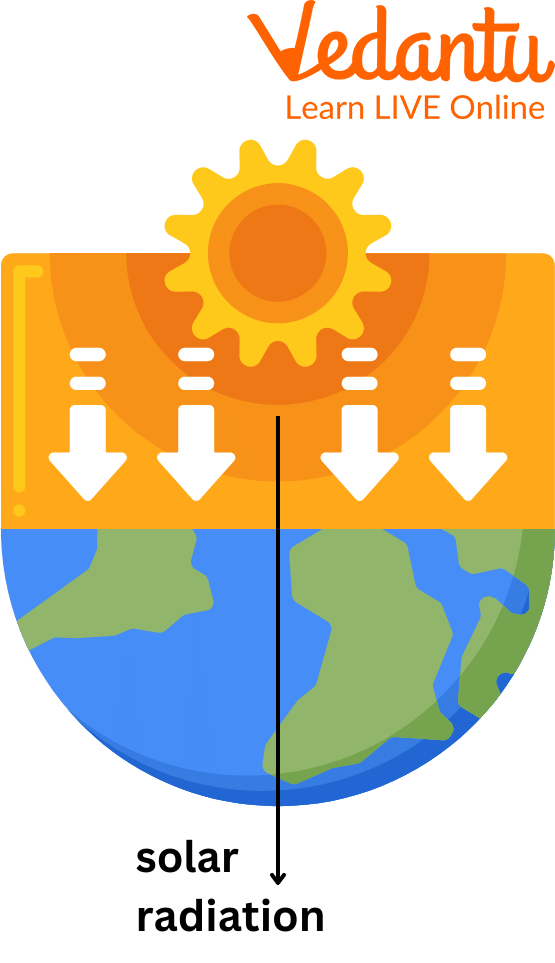




Overview: Sneak Peek into the Topic
You've probably experienced the warming heat transfer if you've ever stood close to a campfire or in front of a fireplace. Your body also gets warm on the side closest to the fire, but the opposite side is untouched by the heat. Even though the air surrounds you, it is not responsible for this heat transmission. The same principles apply to heat lamps used to keep meals warm.
Radiation is the electromagnetic transmission of heat energy from the sun. The heat coming from the sun to earth is because of these radiations too. Let’s learn more about solar radiation and energy emission from the sun in depth.
The Heat in Solar Radiation is Mainly Due to?
Solar radiation is a broad word for the electromagnetic energy that the sun emits. It is also sometimes called the solar resource or just sunshine. The heat in solar radiation is mainly due to infrared radiation (infrared radiation is waves that have longer wavelengths than visible light). These infrared radiations present in solar radiations give us a warm feeling.

Solar Radiation
Energy in the form of Waves
The primary source of energy and heat is our sun. It generates solar energy or fuel for the weather and environmental processes. The term "solar radiation" refers to the sun's energy. Isolation is the term for the incoming radiation to the earth, which travels there as short waves.
Magnetic and electric field vibrations transfer energy in electromagnetic waves. Heat energy reaches the earth in the form of electromagnetic waves. Since there is no medium in space for the waves to travel, these waves reach the earth by radiation (it is the transfer of heat energy through electromagnetic radiation).
How Does Energy Come From the Sun?
There is a reason why Earth is the only known location in the Solar System where life may exist and flourish.
The fact that the Earth is located in the Habitable Zone of our Sun, often known as the "Goldilocks Zone," is one of the causes. The sun, like all stars, is essentially a big nuclear fusion reaction, hence it has the power to produce energy. According to the Nebula Theory, scientists think this started when a massive cloud of gas and particles, or nebula, fell under the weight of its gravity.
This led to the formation of the large ball of light in the centre of our solar system as well as the beginning of a process when hydrogen that had gathered in the centre started to fuse to produce solar energy. The energy generated by the sun reaches earth in the form of electromagnetic waves.

Solar Panel
Facts About Solar Energy
Some interesting facts about solar energy are as follows:
The world's most accessible energy source is solar electricity.
The most rapidly expanding source of energy is solar electricity.
There is no pollution produced while generating solar energy.
It is the fastest source of energy to deploy.
Solar energy users save up to 35 tons of carbon dioxide and 75 million barrels of oil each year.
Plants and animals have been using solar energy since the beginning of time.
200 homes can be powered by 1MW of solar energy.
Summary
From the article, how does the sun warm the earth, we have learnt about the heat coming from the sun and about solar radiation, which is a broad word for the electromagnetic radiation that the sun emits. It is also sometimes referred to as the solar resource or just sunshine. A variety of devices can be used to catch solar radiation and transform it into useful forms of energy, such as heat and electricity.
Solar power is the key future production technology in the shift to clean energy, and as prices decline due to economies of scale, its significance will only grow. The fact that it is a clean, renewable source of electricity is its greatest benefit. Solar energy can be expanded.
FAQs on How Does the Sun Warm the Earth?
1. What are solar radiations made of?
Solar radiation contains visible light, ultraviolet light, infrared, radio waves, X-rays, and gamma rays.
2. What function does solar radiation serve?
Solar radiation is the sun's radiant energy. It is significant because it supports photosynthesis and gives the Earth heat and light. The health of the environment and its people depends on this radiant energy.
3. Does sunlight have an impact on climate?
The balancing act between radiation from the sun, outgoing thermal radiation, and the nature of Earth's atmosphere determines the temperature and climate of the planet.
4. How does heat energy reach the earth?
Heat energy reaches the earth in the form of electromagnetic waves. When this energy reaches earth, it will be converted into thermal energy by evaporating water molecules in the air and causing them to disperse into other molecules.
5. How does the sun create energy for the earth?
The energy emission from the sun is a result of nuclear fusion. Nuclear fusion is the process by which two light nuclei, such as two protons, combine to form a heavier nucleus. The new nucleus is called a neutron. The process releases heat and light energy in the form of electromagnetic radiation.









